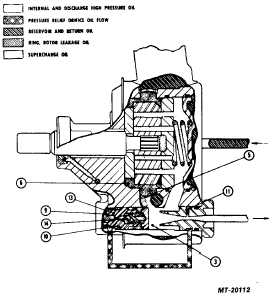|
| |
TM 5-4210-230-14&P-1
TRUCK SERVICE MANUAL
STEERING
The pressure unbalance then causes the valve to
compress the spring (10) allowing the major portion of the oil
to bypass into the intake chamber (from 3 to 6) in the same
manner as is accomplished by flow controlling. Relief
pressures are usually between 5170 and 9995 kilopascals
(750 and 1450 PSI) depending on the vehicle requirements.
Fig. 6 Pressure Relief
MAINTENANCE
FLUID LEVEL
1.
Run engine until power steering fluid reaches normal
operating temperature, approximately 80°C (170°F),
then shut engine off. Remove reservoir filler cap and
check oil level.
2.
If oil level is low, add power steering fluid to proper
level and replace filler cap. For lubrication intervals
refer to operator's manual. For types of lubricant
recommended refer to Lubrication Section CTS-2412.
3.
When checking fluid level after the steering system has
been serviced, air must be bled from the system.
Proceed as follows:
a.
With wheels turned all the way to the left, add power
steering fluid to level indicated on reservoir.
b.
Start engine, and running at fast idle, recheck fluid
level. Add fluid if necessary.
c.
Bleed system by turning wheels from side to side
without hitting stops. Maintain fluid level just above
internal pump casting. Fluid with air in it will have a
light tan or milky appearance. This air must be
eliminated from fluid before normal steering action
can be obtained.
d.
Return wheels to center position and continue to run
engine for two or three minutes, then shut engine
off.
e.
Road-test vehicle to make sure steering functions
normally and is free from noise.
f.
Recheck fluid level as described insteps 1 and 2.
BELT TENSION
A belt that has been previously tensioned is considered to
be a used belt and should be tightened to from 245 to 311
Newtons (55 to 70 lbs.) A belt that has never been tensioned
is considered to be a new belt and should be tightened to 445
Newtons (100 lbs.).
Place Belt Tension Gage SE-2312 or equivalent, midway
between the pulleys on drive belt being checked.
BELT ADJUSTMENT
When adjusting a power steering pump belt, never pry
against the pump reservoir or pull against the filler neck. To
increase belt tension move the pump outward by prying
against the bracket pry lugs or against the pump housing
casting extension directly behind the pump drive pulley.
1.
When power steering pump is driven by a single belt:
a.
Loosen the pump attaching bolts and adjust the belt
to correct tension by moving the pump outward,
away from the engine.
b.
Snug all pump mounting bolts and remove pry bar.
c.
Tighten all pump mounting bolts to specified torque.
d.
Check belt tension.
2.
When the power steering pump is driven by two belts in
a matched set:
a.
Follow same checking and adjusting procedure as 1
above, but if it is necessary to replace one belt, both
must be replaced by a new matched set to equalize
belt tension in both belts. Check tension in both
belts.
3.
When the power steering pump pulley is driven by one
primary belt and is used as an idler for a second belt
driving some other accessory:
CTS-2296R Chapter 1, Page 5
PRINTED IN UNITED STATES OF AMERICA
|

